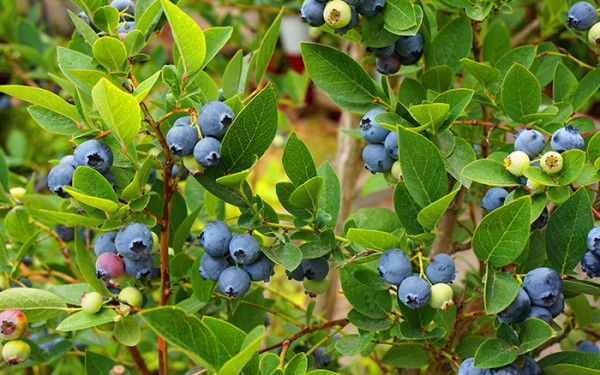Not only are the berries full of flavour but they contain anthocyanin, which gives amazing health benefits. This is also the pigment that gives blueberries their colour. In fact, blueberries are one of the only foods that are naturally blue in colour. So here’s a guide to growing blueberries.
It was the Native Americans who first recognised the health benefits and adaptability of blueberries. They were used for their medicinal purposes and as a natural flavouring and colourant. They called the fruits ‘star fruit’ because of the five-pointed star that forms at the end of the berry. Today the world’s production of blueberries is over 800,000 tonnes – so they’re incredibly popular fruits!
Burst of berries
Blueberries are great shrubs to have planted within flower borders with other acid loving ornamentals. Not only do they have pretty white flowers in spring, but the leaves turn a gorgeous shade of red-yellow before falling in autumn. Then of course there’s the added bonus of tasty, nutritious fruit in the summer.
Blueberries can be bought as container grown plants so they can be planted at any time of the year. Although, it’s best to plant them during their dormant period which is between November and March.
To grow successfully, blueberries need acidic soil. But if your garden soil isn’t suitable, they grow well in containers full of peat-free ericaceous compost. Another benefit of growing blueberries is that they are relatively compact, usually growing to around 1.2m tall, so they are even well-suited for small gardens.
Plant by digging a hole and mixing in a layer of organic matter and placing the roots of the plant at the same depth as their original growth. Give them a good start with an ericaceous plant food and water them in well. If possible, use rainwater for blueberries. This is because tap water is alkaline and can increase the pH level, making conditions less acidic. Adding a layer of mulch around the roots is great for retaining moisture, insulating the roots, and supressing weeds too.

Types to try
Some varieties of blueberries are self-pollinating. However, it’s still ideal to grow 2 or 3 different varieties which will increase the chances of cross-pollination and a successful harvest. When choosing which blueberry varieties to grow, bear in mind that different types fruit at different times of the year. So, choosing wisely can mean you have fruit for a longer period of time.
For an early cropping fruit, ‘Duke’ is a fantastic choice. Growing up to 2 metres tall, this variety will bloom in late spring followed by light blue berries in June and July. The berries have a mildly sweet flavour, and you can have a high yield once the plant has matured with long-lasting fruits.
Mid-cropping ‘Bluejay’ has delicately sweet fruit that’s medium in size from July. The fruit is a great one for eating fresh as well as freezing, cooking, and preserves. Late-cropping ‘Chandler’ produces large blue-black berries from August until September on a plant that grows up to 1.5m tall.
Choosing a variety of cultivars will even help to produce larger fruits due to cross-pollination, so mix and match for the best results.

Growing goodness
The trick with harvesting these superfruits is to harvest in stages. From mid-summer to early autumn the blueberries will ripen. When they have turned completely blue, they can be picked and stored. When the stock has built up, you can use your harvests to create tasty dishes such as blueberry muffins, jam, smoothies, or baked oats.
Low in calories and high in nutrients, blueberries are thought to have one of the highest antioxidant levels of all common fruit and veg. The little fruits are small but mighty. They’ve been linked to lowering blood pressure, preventing heart disease, and improving brain function and memory.

Don’t feel blue
When growing blueberries there are a few things to keep an eye out for to ensure you get the best harvest and decrease the chances of any problems arising. For example, birds may try to get to your berries before you have chance too, so it’s ideal to cover the shrubs with mesh or horticultural fleece as a barrier. But it’s important that you only put this protection on after the berries have started to fruit because doing prematurely may mean bees and other pollinators can’t get to the plant to pollinate it.
Another problem that can occur is powdery mildew which is a fungal disease that can be spotted by a white powder on the leaves. It can occur as a sign of stress, so keep the likelihood low by watering the plants regularly so the soil doesn’t dry out and keeping the plants cool by ensuring there’s a layer of mulch to protect the roots.
When growing through winter, blueberries might need protection from the frost, especially in cold areas. Protect the buds by covering the plant with fleece or move container-grown blueberries inside for a short while.


Leave A Comment